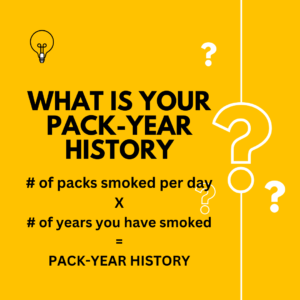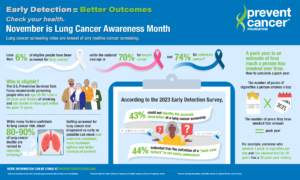Can we talk about how hard lung cancer is hitting our community, especially Black men? George “Funky” Brown, the co-founder and drummer with Kool & The Gang just succumbed to the disease recently. According to the National Cancer Institute, our brothers are more likely to die from the disease. But overall, Black men and women are diagnosed at an earlier age. And they may receive that diagnosis even though they may smoke fewer packs than white smokers. However, how we smoke is a factor. Smokers in our community tend to smoke each cigarette longer, increasing our exposure to tobacco’s harmful ingredients. But lung cancer is the leading cause of death among all cancers, so why aren’t we being screened?
When compared to other cancer screenings, lung cancer has significantly less participation. The national average for breast cancer is 70%, 74% for colorectal cancer, and lung cancer has just 6% participation.
How Do You Know If You Qualify for a Screening?
A key reason is confusion about what screenings are and who qualifies for them. A contributing factor is a smoker’s or ex-smoker’s pack-year history. It is factored by multiplying the number of packs per day smoked by the number of years they’ve smoked, and the total equals their pack-year history.

Here are some other factors that qualify us for routine screenings:
- Age 50-80
- 20-pack-year history
- Still a smoker or have quit in the past 15 years
What Happens During a Screening?
A critical reason to start having routine screenings is an opportunity to be diagnosed earlier—resulting in less extensive treatments, expanded treatment options, and an increased chance of survival. However, an early detection survey conducted by PreventCancer.Org reported that only 43% of respondents could describe what happened during a screening. We are here to help.
The Centers for Disease Control says the recommended screening test is a low-dose computed tomography (aka a low-dose CT scan or LDCT).
The non-invasive test involves lying on a table and an X-ray machine using low doses of radiation to capture detailed images of your lungs. The test takes a few minutes, and it is pain-free.
What if The Smoker is a Friend, Parent, or Other Loved One?
Even if you aren’t a smoker, you probably know someone who may need to be screened. So what do you think you should do? Start a dialogue with them about the benefits of screenings and the importance of early detection. Help them figure out their pack-year history. The American Lung Association also offers a few tips, two you might want to consider:
- If they are concerned about costs, let them know there is no charge for the procedure if they are high-risk.
- Offer to make the screening appointment for them. Or you can offer to accompany them.
- Give them time to absorb the information and reopen the conversation.
Check out the infographic below for more quick facts about lung cancer and screenings:







